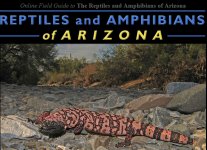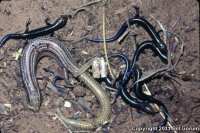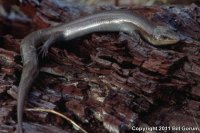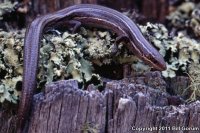| Range: |
 |
| Other Names: |
|
| Subspecies: |
Variable Skink Plestiodon multivirgatus epipleurotus |
| Description: |
A small (up to 76 mm or 3" from snout to vent), shiny lizard with a very long, thick tail (when not regenerated), a stout body, and small limbs. The neck is thick and the head is small. Coloration is tan, cream, gray-brown, or olive gray. Markings consist of a thin, pale stripe on each upper side and numerous alternating brown and olive gray stripes on the back and lower sides. Stripes may be muted or absent on some specimens. The underside is cream or gray. Young are darker and have a bright blue tail. Some males develop red or orange coloration on the lips during breeding season. The scales are large, rounded, smooth, and very shiny. Its numerous stripes and very long tail (up to twice the length of the body when not regenerated) distinguish this lizard from other skinks in New Mexico. |
| Similar Species: |
The Great Plains Skink is larger, lacks distinct stripes,is black as a juvenile or light yellowish-brown to tan as an adult and has lateral scale rows that are oblique to the dorsal scale rows. The Mountain Skink lacks a light middorsal stripe, has the dorsolateral light stripe confined to the 4th scale row from the midline, often has a light Y-shaped mark on the head with its base located on the neck, has an undivided postmental scale or, if divided, has lateral light stripes passing above the ear opening. |
| Venom: |
None |
| Habitat: |
This lizard is found in Plains and Great Basin Grassland, Great Basin Conifer Woodland, and Petran Montane Conifer Forest communities. It inhabits moist open prairies, wooded foothills, sunny areas on forested slopes, and rugged canyon bottoms. It is most frequently found under rocks, logs, and other surface cover. |
| Behavior: |
This ground-dweller is active during the day but most activity occurs under surface cover or on moist overcast days. When spotted it can be quite difficult to capture as it quickly slides and zigzags through the grass, rocks, or surface debris. It is capable of casting off (and regenerating) the tail. Pursuers and predators often end up with nothing but a wiggling tail. |
| Hibernation: |
Eggs are laid in shallow nests that are usually excavated from moist soil under logs, rocks, or other surface cover. Clutch size ranges from 3 to 9 eggs. The female remains in the nest with the eggs to guard them. |
| Reproduction: |
|
| Diet: |
The Many-lined Skink feeds on ant larvae and probably a variety of other insects. |
Adapted from account at reptilesofaz.org
Sources:


|













